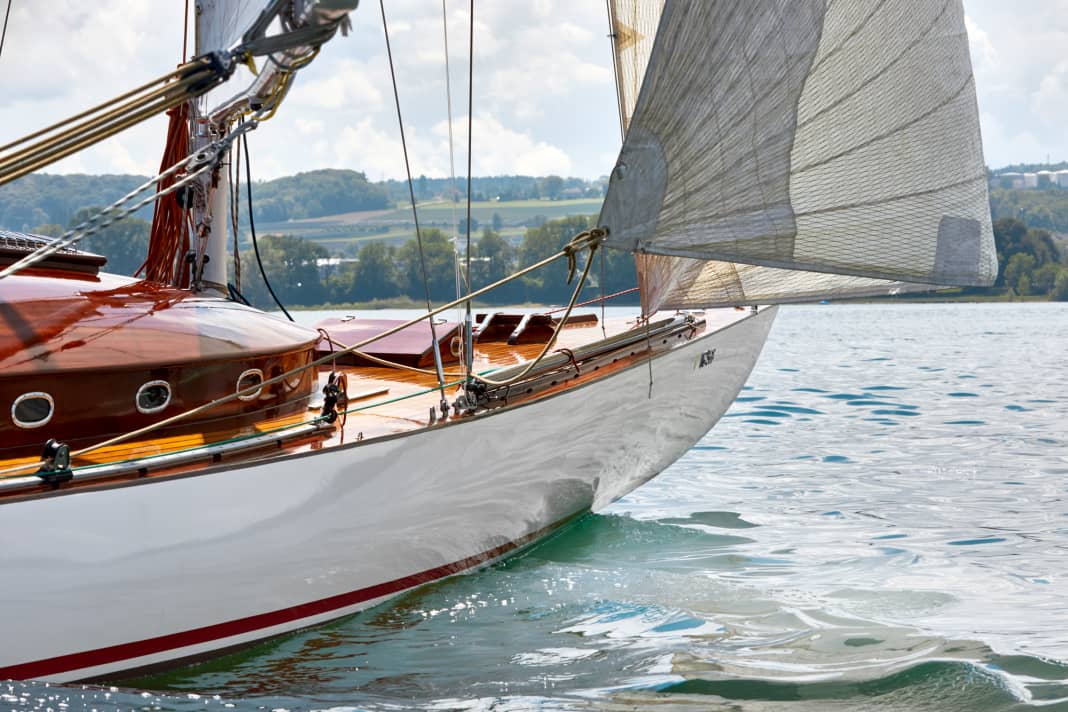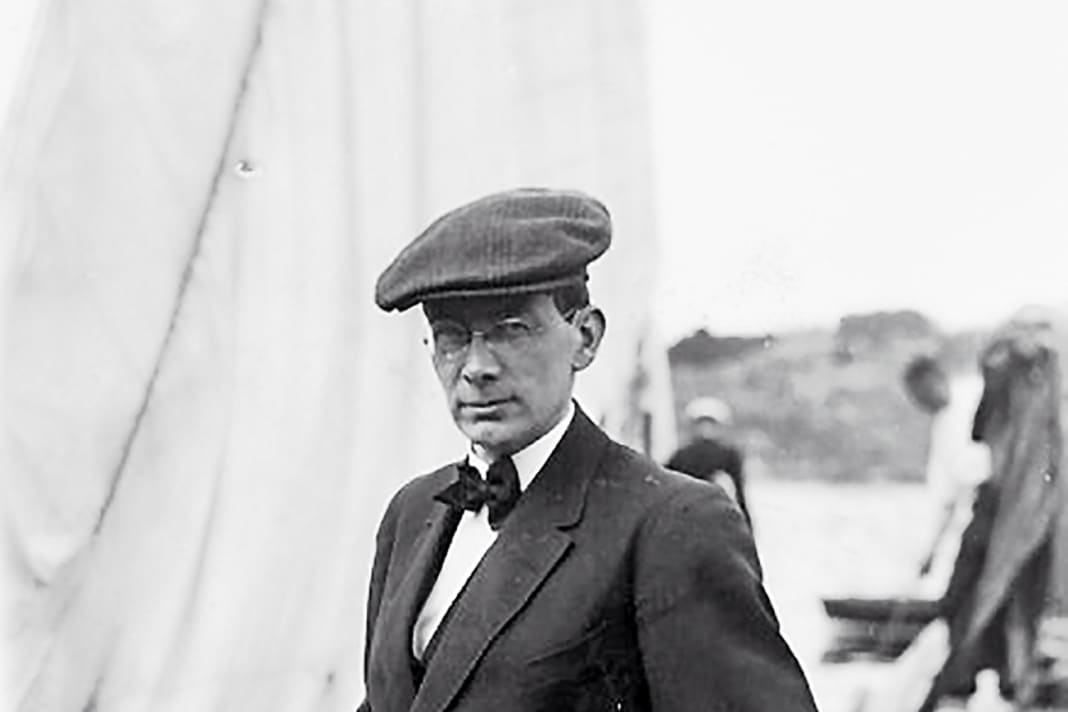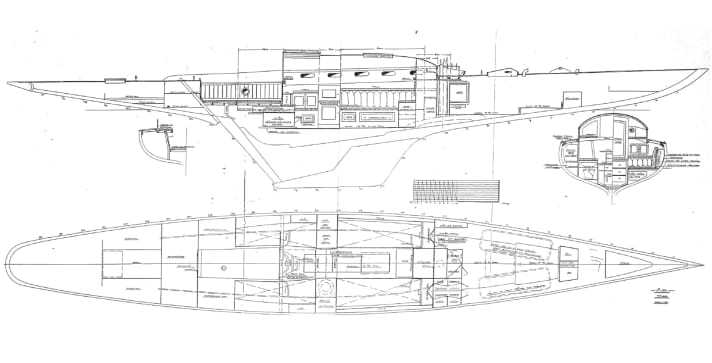75-series warping cruiser: "Gun" enriches the classic scene on Lake Constance
Michael Good
· 21.01.2024






The others claim that Willi is the real boss. Willi, on the other hand, says: "We are all the boss!" So that remains unclear. It is well known that the members of the Swiss owner conglomerate were and are not always in complete agreement anyway. Except for one essential point: their ship, the "Gun", which they have owned since 2012, is the most beautiful on the whole of Lake Constance!
Long, narrow and fast - these are the attributes with which the "Gun" can be roughly characterised. The sheer numbers alone are impressive: 16.60 metres long, i.e. just under 55 feet, yet only 2.58 metres wide, which corresponds to an aspect ratio of 6.5:1. By comparison, the ratio of length to width on modern cruising or regatta yachts is generally 3:1. The lengths of the overhangs at the ends of the ship are also remarkable. The waterline of the "Gun" is measured over just 10.40 metres, resulting in overhangs of more than six metres at the bow and stern. Of course, this is only supposedly excess wood, which becomes effective when the ship is pushed into position and pulled through the water over its full length.
The Swedish-built archipelago cruiser lands in Switzerland
Length runs, that was the motto more than 100 years ago. Erik Salander was the man who designed the "Gun" towards the end of the First World War. Salander, also known as the "Master of Lines", had already designed the "Ila" two years earlier, also a 75-metre skerry cruiser and the sister ship of the "Gun". The "Ila" has also survived to this day and is currently still being sailed in Helsinki. As far as is known, the history of the two almost identical ships runs parallel for long stretches. Both 75s were built one after the other at the Hästholmsvarvet shipyard in the Stockholm area and later sold to Finland, both to Helsinki, after an active regatta life in Sweden and numerous changes of ownership.
In 2012, however, the seemingly inseparable sisters went their separate ways after all. The last owners of the skerry cruiser "Gun" in Finland, the Jacoby family, had put the 16-metre-long vessel up for sale. And suddenly there were interested parties from Switzerland, who had apparently spontaneously fallen in love with the "Gun". The deal was soon struck, the ship was quickly loaded in Helsinki and transported to Lake Constance on a low-loader.
Even Willy Sauter, who the others see as the boss, admits that they were rather naïve in their approach. In fact, the threads of the syndicate have been running through him for many years; he was probably the one who discovered the advert for the sale of the "Gun" on the internet. Of course they knew that the ship was more than 16 metres long. The new owners on Lake Constance were initially unable to answer the question of where it could ultimately be moored and docked; harbour locations for ships of this length are not only a rarity there. It was agreed that a solution would somehow be found in due course. First of all, the ship had to be found.
However, a dramatic circumstance brought the project very close to the brink of failure. Immediately before the sale to the Swiss, the tall and thin carbon fibre mast came down from above in three pieces during a trip in strong winds in Finland. However, because the Swiss had a lot of experience in dealing with carbon fibre from previous projects, they decided to take over the ship anyway and repair the mast on a trial basis, naturally with a certain price reduction. The good thing about this was that the mast could easily be transported to Lake Constance on the ship in three handy pieces, jokes one of the team members.
General overhaul is due
However, the collective can only really laugh heartily about such jokes today. The busy Swiss team had to invest more than 700 hours of work during the winter of 2012/13 to restore the almost 23 metre long rig. Co-owner Clemens Dransfeld, a professor specialising in composite materials, used his expertise to coordinate the work at the time and was also responsible for the structural calculations - with great success. Now the slim, filigree and dazzlingly white painted three-saloon rig has been rebuilt on the "Gun" and put through its paces. So far, everything has held up perfectly.
And there was another cause for concern at the beginning: the Isuzu diesel engine, which had probably been installed sometime in the seventies or eighties, had completely run out of steam when it was taken over. So a new unit was needed. Today, a Nanni diesel with 30 hp power purrs in the belly of the "Gun", with shaft drive to the propeller well.
Initially, the ship had to go to the shipyard for a general overhaul anyway. During her time in Helsinki, archipelago cruiser "Gun" was apparently never really covered by the owners at the time; sun, salt and acid rain had taken their toll on the surfaces over the years. The deck, the cabin superstructure and all parts of the cockpit were completely stripped and repainted by the new owners in Switzerland. And the wooden deck made of American Douglas fir was also given a thick coat of varnish.
Time travel on the skerry cruiser
Incidentally, the "Gun" was made with carvel planking from Honduras mahogany. The keel and deadwood are made of oak. In the course of history, which in the case of the "Gun" is unfortunately only very poorly and incompletely documented, a solid steel frame was also built into the boat; this was to strengthen the structure and consequently probably also to absorb the forces from the higher rigging. Initially, from 1918, the ship carried a gaff rig; it was only later rigged higher and finally fitted with a modern and powerful rig made of carbon fibre. However, it remains unknown exactly when these modifications were carried out and by whom.
If you go below deck on the "Gun", you will embark on a veritable journey through time. Blue velour upholstery with buttons, dark mahogany varnished to a high gloss, turned handrails and newly polished brass fittings characterise the picture. You are literally immersed in a world of bygone days - genuine and unadulterated. This is how it used to be, 100 years ago. There is now even electricity on board, but only for running the dugout engine. Otherwise, a beautifully crafted skylight provides a little natural illumination during the day and a paraffin lamp creates a cosy, dimly lit atmosphere in the evening.
Which the Swiss like to savour to the full at the end of the season. On the evening before the launching date, the heat is turned up below deck and a fondue is prepared, in keeping with good local tradition. Then they all sit below deck in the steam of the cheese soup, and later they smoke cigars. Meanwhile, nobody has to worry about the bad air, because the ship is already going into winter storage the next day with plenty of time to air out.
The name "Gun" has nothing to do with weapons
Actually, everything would have been quite simple. Some time ago, the Carondimonio owners' association supposedly put an end to their wild racing years with the fiery red Libera racer of the same name. The Swiss-built racing goat, commonly disparaged as a "monkey mound", with its wide outriggers, twelve trapezes and an almost ridiculously high mast, has not only won the trophies of almost all long-distance regattas on Lake Constance. After these days, the "Carondis", as they are still called today, actually wanted to settle down in terms of sailing, for example with a 30-metre skerry cruiser in their sights. "That might have been the sensible thing to do," they admit, behind closed doors and only half-seriously. But these Swiss have never been very good at common sense.
Fortunately for the "Gun", which today, thanks to the intensive care of its carers and despite its impressive age, still looks as if it had been launched straight from the pile. And fortunately for the lively classic car scene on Lake Constance, which has been enriched by a real gem.
The Swiss would like to have one thing clarified. The name "Gun" has nothing to do with weapons, neither with cannons nor pistols or rifles. Gun is a woman's name in Sweden. That's reassuring to know.
Designer Erik Salander, the master of lines



He penned the cracks of many skerry cruisers that were built in Sweden between 1910 and 1920. Designer Erik Andreas Salander (1883-1957) was known for his fast and beautiful designs, especially for 55, 75 and 95-metre skerry cruisers. His work played a decisive role in the development of early sailing in his day. Most of the yachts were built at the Hästholmsvarvet shipyard near Stockholm, including the two imposing 75-metre skerry cruisers "Ila" (1916) and "Gun" (1918).
Technical data of the 75 "Gun" warping cruiser

- Designer:Erik Salander
- Torso length:16,60 m
- LWL:10,40 m
- Width:2,58 m
- Depth:1,90 m
- Weight:5,35 t
- Ballast/proportion:2,45 t/46 %
- Sail area on the wind:75,0 m²
The article appeared in YACHT issue 24/2018 and was revised for the online version.

